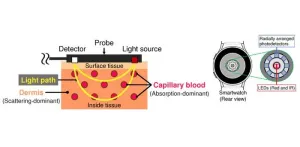(Press-News.org) Researchers have developed a machine learning algorithm to accurately detect heart murmurs in dogs, one of the main indicators of cardiac disease, which affects a large proportion of some smaller breeds such as King Charles Spaniels.
The research team, led by the University of Cambridge, adapted an algorithm originally designed for humans and found it could automatically detect and grade heart murmurs in dogs, based on audio recordings from digital stethoscopes. In tests, the algorithm detected heart murmurs with a sensitivity of 90%, a similar accuracy to expert cardiologists.
Heart murmurs are a key indicator of mitral valve disease, the most common heart condition in adult dogs. Roughly one in 30 dogs seen by a veterinarian has a heart murmur, although the prevalence is higher in small breed dogs and older dogs.
Since mitral valve disease and other heart conditions are so common in dogs, early detection is crucial as timely medication can extend their lives. The technology developed by the Cambridge team could offer an affordable and effective screening tool for primary care veterinarians, and improve quality of life for dogs. The results are reported in the Journal of Veterinary Internal Medicine.
“Heart disease in humans is a huge health issue, but in dogs it’s an even bigger problem,” said first author Dr Andrew McDonald from Cambridge’s Department of Engineering. “Most smaller dog breeds will have heart disease when they get older, but obviously dogs can’t communicate in the same way that humans can, so it’s up to primary care vets to detect heart disease early enough so it can be treated.”
Professor Anurag Agarwal, who led the research, is a specialist in acoustics and bioengineering. “As far as we’re aware, there are no existing databases of heart sounds in dogs, which is why we started out with a database of heart sounds in humans,” he said. “Mammalian hearts are fairly similar, and when things go wrong, they tend to go wrong in similar ways.”
The researchers started with a database of heart sounds from about 1000 human patients and developed a machine learning algorithm to replicate whether a heart murmur had been detected by a cardiologist. They then adapted the algorithm so it could be used with heart sounds from dogs.
The researchers gathered data from almost 800 dogs who were undergoing routine heart examination at four veterinary specialist centres in the UK. All dogs received a full physical examination and heart scan (echocardiogram) by a cardiologist to grade any heart murmurs and identify cardiac disease, and heart sounds were recorded using an electronic stethoscope. By an order of magnitude, this is the largest dataset of dog heart sounds ever created.
“Mitral valve disease mainly affects smaller dogs, but to test and improve our algorithm, we wanted to get data from dogs of all shapes, sizes and ages,” said co-author Professor Jose Novo Matos from Cambridge’s Department of Veterinary Medicine, a specialist in small animal cardiology. “The more data we have to train it, the more useful our algorithm will be, both for vets and for dog owners.”
The researchers fine-tuned the algorithm so it could both detect and grade heart murmurs based on the audio recordings, and differentiate between murmurs associated with mild disease and those reflecting advanced heart disease that required further treatment.
“Grading a heart murmur and determining whether the heart disease needs treatment requires a lot of experience, referral to a veterinary cardiologist, and expensive specialised heart scans,” said Novo Matos. “We want to empower general practitioners to detect heart disease and assess its severity to help owners make the best decisions for their dogs.”
Analysis of the algorithm’s performance found it agreed with the cardiologist’s assessment in over half of cases, and in 90% of cases, it was within a single grade of the cardiologist’s assessment. The researchers say this is a promising result, as it is common for there to be significant variability in how different vets grade heart murmurs.
“The grade of heart murmur is a useful differentiator for determining next steps and treatments, and we’ve automated that process,” said McDonald. “For vets and nurses without as much stethoscope skill, and even those who are incredibly skilled with a stethoscope, we believe this algorithm could be a highly valuable tool.”
In humans with valve disease, the only treatment is surgery, but for dogs, effective medication is available. “Knowing when to medicate is so important, in order to give dogs the best quality of life possible for as long as possible,” said Agarwal. “We want to empower vets to help make those decisions.”
“So many people talk about AI as a threat to jobs, but for me, I see it as a tool that will make me a better cardiologist,” said Novo Matos. “We can’t perform heart scans on every dog in this country – we just don’t have enough time or specialists to screen every dog with a murmur. But tools like these could help vets and owners, so we can quickly identify those dogs who are most in need of treatment.”
The research was supported in part by the Kennel Club Charitable Trust, the Medical Research Council, and Emmanuel College Cambridge.
END
AI algorithm accurately detects heart disease in dogs
2024-10-29
ELSE PRESS RELEASES FROM THIS DATE:
What animal societies can teach us about ageing
2024-10-29
Red deer may become less sociable as they grow old to reduce the risk of picking up diseases, while older house sparrows seem to have fewer social interactions as their peers die off, according to new research which shows humans are not the only animals to change our social behaviour as we age.
A collection of 16 studies, including six from the University of Leeds, have been published today as part of a special issue of the Philosophical Transactions of the Royal Society, investigating ageing and society across the natural world.
One study into red deer shows that ...
Enhancing the accuracy of wearables that measure blood glucose levels
2024-10-28
Diabetes is an increasingly pervasive disease, currently affecting over 500 million adults worldwide. Since there is as yet no cure for type 1 or type 2 diabetes, patients must regularly monitor their BGLs to keep them in check. Though BGL-measuring devices relying on painful finger pricks have been the gold standard for decades, modern technology is slowly opening doors to better alternatives.
Many researchers have proposed noninvasive methods to monitor BGLs using widely available wearable devices, such as smartwatches. For example, by placing the LEDs ...
Increasing social supports for new mothers with opioid use disorder
2024-10-28
Opioid use disorder (OUD) is a growing public health problem among pregnant and parenting people in the U.S. Between 1999 and 2014, the number of pregnant women with OUD increased by more than four times. This trend also coincides with a rise in pregnancy-associated maternal overdose mortality.
Researchers at Thomas Jefferson University, led by Meghan Gannon, PhD, MSPH, investigated how community-based supports, like doulas, can be integrated into health care for mothers who use opioids. Using a social network analysis, ...
Mitigating the neurotoxic effects of lead exposure
2024-10-28
Lead exposure is a risk to any human, but children are most vulnerable to the element’s neurotoxicity, which can lead to developmental delays, learning difficulties and mood changes among other symptoms. There has been some progress in reducing exposure and preventing neurotoxicity, but hundreds of thousands of American children are still affected.
A new study by Thomas Jefferson University neuroscientist Jay Schneider, PhD, suggests that the toxic effects of lead can be mitigated by attentive maternal care and an enriched environment ...
Developing kidneys from scratch
2024-10-28
To Alex Hughes, Assistant Professor in Bioengineering within Penn Engineering and in Cell and Developmental Biology within Penn Medicine, the kidney is a work of art. “I find the development of the kidney to be a really beautiful process,” says Hughes.
Most people only ever see the organ in cross-section, through textbooks or by dissecting animal kidneys in high school biology class: a bean-shaped slice with lots of tiny tubes. “I think that really undersells how amazing the structure is,” says ...
Airbnbs associated with more crime in London, new study shows
2024-10-28
Since its founding in 2008, the short-term homestay platform Airbnb has expanded to 100,000 cities in more than 220 countries, and, according to data from the company, 1.5 billion guests had stayed in Airbnb-listed properties through 2023.
Much of the academic research on Airbnb activity comes from economics and business literature and focuses on housing-supply impacts, says David Kirk, professor of criminology at the University of Pennsylvania. Yet research on neighborhood impacts is limited, and that research neglects the impacts of Airbnb activity on measures of community cohesion and safety.
Kirk teamed with University of Cambridge criminologist ...
New study finds invasive plants drive homogenization of soil microbial communities across U.S.
2024-10-28
Invasive plants are doing more than just taking over landscapes — they’re also changing the soil beneath them. A new study co-authored by Matthew McCary, assistant professor of biosciences at Rice University, reveals that these species are reshaping soil microbial communities across the U.S., making them more uniform and altering how ecosystems function. The findings, published in Proceedings of the National Academy of Sciences on Oct. 24, shed light on the far-reaching impacts of invasive plants, which extend beyond what we see above ground.
The ...
Researchers’ new outreach strategy succeeds, sets blueprint for detecting invasive species in Florida
2024-10-28
Invasive species in Florida like Nile monitors and Argentine black-and-white tegus pose a growing threat to the Sunshine State’s environment, economy and public safety. South Florida’s warm climate, disturbed habitats and bustling pet trade have made it a hotspot for these non-native, cryptic reptiles. However, finding these elusive creatures has always been a challenge – until now.
University of Florida researchers are showcasing how a focused outreach initiative in Palm Beach County has led to a successful increase in reports of invasive reptiles in Florida. The findings are documented in the latest study published in Scientific Reports and authored by researchers at UF/IFAS ...
Discovery of critical iron-transport protein in malaria parasites could lead to faster-acting medications
2024-10-28
Malaria kills over 600,000 people a year, and as the climate warms, the potential range of the disease is growing. While some drugs can effectively prevent and treat malaria, resistance to those drugs is also on the rise.
New research from University of Utah Health has identified a promising target for new antimalarial drugs: a protein called DMT1, which allows single-celled malaria parasites to use iron, which is critical for parasites to survive and reproduce.
The results suggest that medications that block DMT1 might be very effective against malaria.
The new results are published in PNAS.
An ironic mystery
Paul Sigala, ...
Risky choices: How US laws affect migrant children’s journeys to border
2024-10-28
U.S. immigration law and the legal categorizations it imposes on migrants shape the journeys of migrant children from Central America as they move through Mexico toward the southern U.S. border, according to a new Yale study.
In the study, sociologist Ángel Escamilla García documents the various hard decisions Central American youth are forced to make during their journeys to maximize their chances of not being deported once they reach the United States. Those choices include concealing sexual assaults, beatings, and other crimes ...







